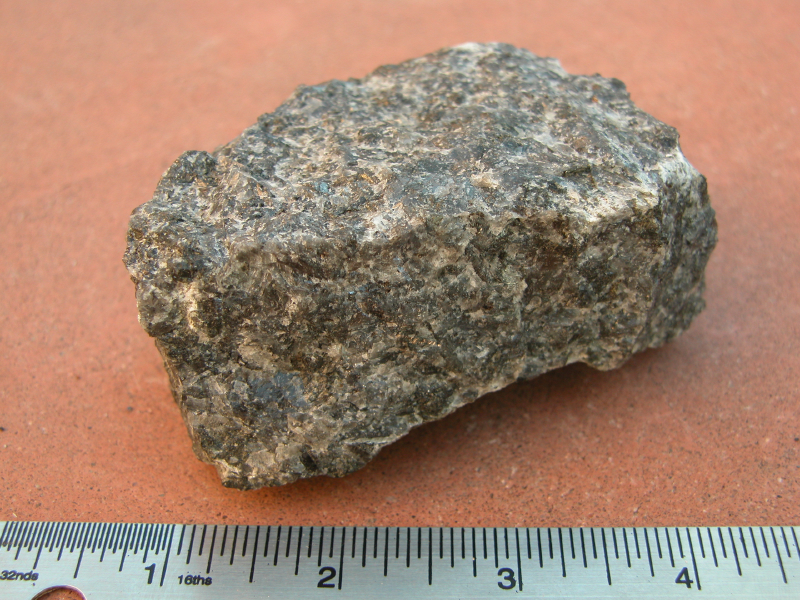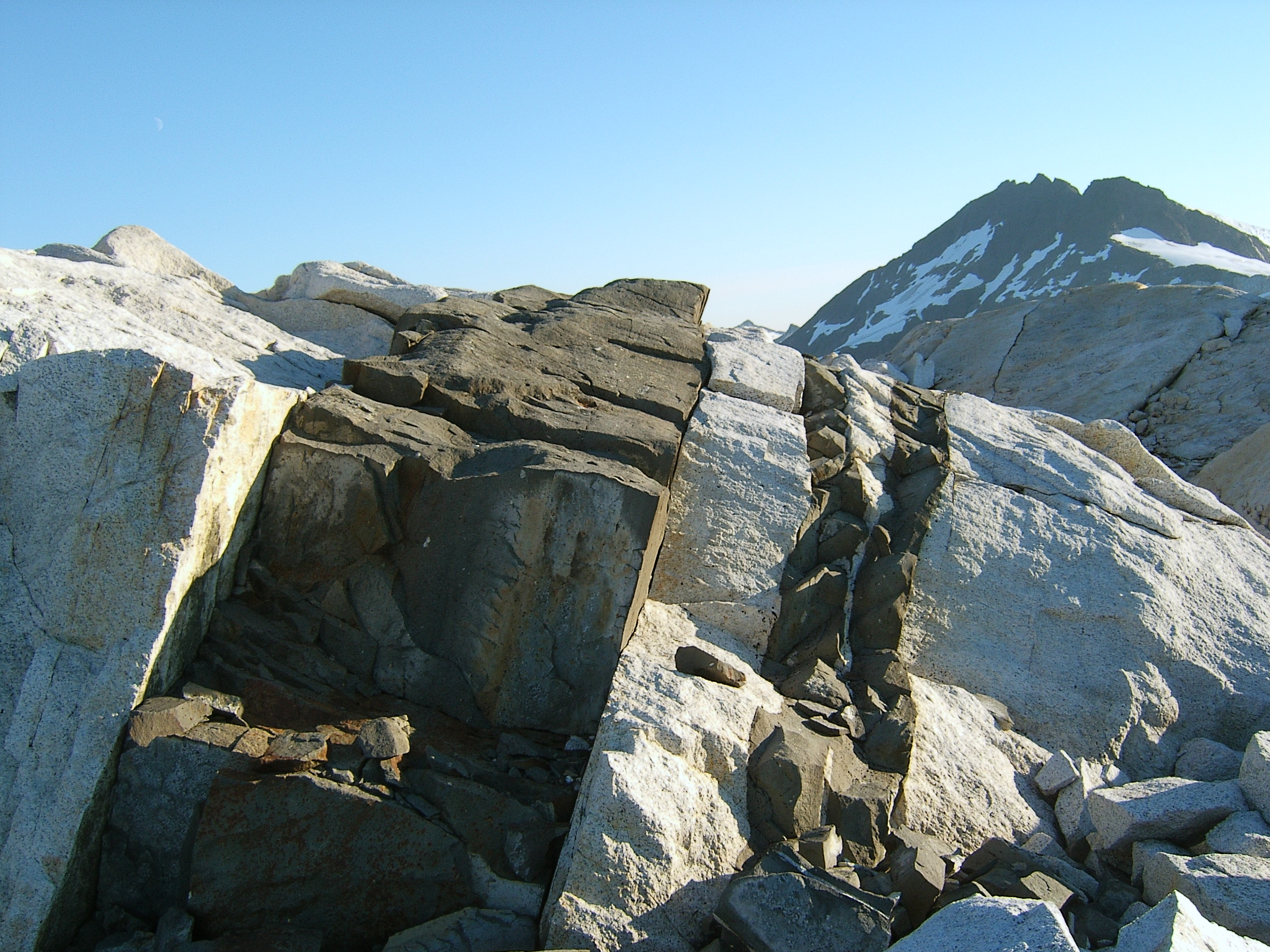|
Igneous
Igneous rock ( ), or magmatic rock, is one of the three main rock types, the others being sedimentary and metamorphic. Igneous rocks are formed through the cooling and solidification of magma or lava. The magma can be derived from partial melts of existing rocks in either a planet's mantle or crust. Typically, the melting is caused by one or more of three processes: an increase in temperature, a decrease in pressure, or a change in composition. Solidification into rock occurs either below the surface as intrusive rocks or on the surface as extrusive rocks. Igneous rock may form with crystallization to form granular, crystalline rocks, or without crystallization to form natural glasses. Igneous rocks occur in a wide range of geological settings: shields, platforms, orogens, basins, large igneous provinces, extended crust and oceanic crust. Geological significance Igneous and metamorphic rocks make up 90–95% of the top of the Earth's crust by volume. Igneous rocks ... [...More Info...] [...Related Items...] OR: [Wikipedia] [Google] [Baidu] |
Granite
Granite ( ) is a coarse-grained (phanerite, phaneritic) intrusive rock, intrusive igneous rock composed mostly of quartz, alkali feldspar, and plagioclase. It forms from magma with a high content of silica and alkali metal oxides that slowly cools and solidifies underground. It is common in the continental crust of Earth, where it is found in igneous intrusions. These range in size from dike (geology), dikes only a few centimeters across to batholiths exposed over hundreds of square kilometers. Granite is typical of a larger family of ''granitic rocks'', or ''granitoids'', that are composed mostly of coarse-grained quartz and feldspars in varying proportions. These rocks are classified by the relative percentages of quartz, alkali feldspar, and plagioclase (the QAPF diagram, QAPF classification), with true granite representing granitic rocks rich in quartz and alkali feldspar. Most granitic rocks also contain mica or amphibole minerals, though a few (known as leucogranites) conta ... [...More Info...] [...Related Items...] OR: [Wikipedia] [Google] [Baidu] |
Rock (geology)
In geology, rock (or stone) is any naturally occurring solid mass or aggregate of minerals or mineraloid matter. It is categorized by the minerals included, its Chemical compound, chemical composition, and the way in which it is formed. Rocks form the Earth's outer solid layer, the Earth's crust, crust, and most of its interior, except for the liquid Earth's outer core, outer core and pockets of magma in the asthenosphere. The study of rocks involves multiple subdisciplines of geology, including petrology and mineralogy. It may be limited to rocks found on Earth, or it may include planetary geology that studies the rocks of other celestial objects. Rocks are usually grouped into three main groups: igneous rocks, sedimentary rocks and metamorphic rocks. Igneous rocks are formed when magma cools in the Earth's crust, or lava cools on the ground surface or the seabed. Sedimentary rocks are formed by diagenesis and lithification of sediments, which in turn are formed by the weathe ... [...More Info...] [...Related Items...] OR: [Wikipedia] [Google] [Baidu] |
Intrusive Rock
Intrusive rock is formed when magma penetrates existing rock, crystallizes, and solidifies underground to form ''Igneous intrusion, intrusions'', such as batholiths, dike (geology), dikes, Sill (geology), sills, laccoliths, and volcanic necks.Intrusive RocksIntrusive rocks accessdate: March 27, 2017.Igneous intrusive rocks, accessdate: March 27, 2017.Britannica.comintrusive rock , geology , Britannica.com accessdate: March 27, 2017. Intrusion is one of the two ways igneous rock can form. The other is extrusive rock, extrusion, such as a Types of volcanic eruptions, volcanic eruption or similar event. An intrusion is any body of intrusive igneous rock, formed from magma that cools and solidifies within the crust of the planet. In contrast, an ''extrusion'' consists of extrusive rock, formed above the surface of the crust. Some geologists use the term plutonic rock synonymously with intrusive rock, but other geologists subdivide intrusive rock, by crystal size, into coarse-grai ... [...More Info...] [...Related Items...] OR: [Wikipedia] [Google] [Baidu] |
Gabbro
Gabbro ( ) is a phaneritic (coarse-grained and magnesium- and iron-rich), mafic intrusive igneous rock formed from the slow cooling magma into a holocrystalline mass deep beneath the Earth's surface. Slow-cooling, coarse-grained gabbro is chemically equivalent to rapid-cooling, fine-grained basalt. Much of the Earth's oceanic crust is made of gabbro, formed at mid-ocean ridges. Gabbro is also found as plutons associated with continental volcanism. Due to its variant nature, the term ''gabbro'' may be applied loosely to a wide range of intrusive rocks, many of which are merely "gabbroic". By rough analogy, gabbro is to basalt as granite is to rhyolite. Etymology The term "gabbro" was used in the 1760s to name a set of rock types that were found in the ophiolites of the Apennine Mountains in Italy. It was named after Gabbro, a hamlet near Rosignano Marittimo in Tuscany. Then, in 1809, the German geologist Christian Leopold von Buch used the term more restrictively in his d ... [...More Info...] [...Related Items...] OR: [Wikipedia] [Google] [Baidu] |
Intrusive Rock
Intrusive rock is formed when magma penetrates existing rock, crystallizes, and solidifies underground to form ''Igneous intrusion, intrusions'', such as batholiths, dike (geology), dikes, Sill (geology), sills, laccoliths, and volcanic necks.Intrusive RocksIntrusive rocks accessdate: March 27, 2017.Igneous intrusive rocks, accessdate: March 27, 2017.Britannica.comintrusive rock , geology , Britannica.com accessdate: March 27, 2017. Intrusion is one of the two ways igneous rock can form. The other is extrusive rock, extrusion, such as a Types of volcanic eruptions, volcanic eruption or similar event. An intrusion is any body of intrusive igneous rock, formed from magma that cools and solidifies within the crust of the planet. In contrast, an ''extrusion'' consists of extrusive rock, formed above the surface of the crust. Some geologists use the term plutonic rock synonymously with intrusive rock, but other geologists subdivide intrusive rock, by crystal size, into coarse-grai ... [...More Info...] [...Related Items...] OR: [Wikipedia] [Google] [Baidu] |
Diorite
Diorite ( ) is an intrusive rock, intrusive igneous rock formed by the slow cooling underground of magma (molten rock) that has a moderate content of silica and a relatively low content of alkali metals. It is Intermediate composition, intermediate in composition between low-silica (mafic) gabbro and high-silica (felsic) granite. Diorite is found in mountain-building belts (''orogens'') on the margins of continents. It has the same composition as the fine-grained volcanic rock, andesite, which is also common in orogens. Diorite has been used since prehistoric times as decorative stone. It was used by the Akkadian Empire of Sargon of Akkad for funerary sculptures, and by many later civilizations for sculptures and building stone. Description Diorite is an intrusive rock, intrusive igneous rock composed principally of the silicate minerals plagioclase feldspar (typically andesine), biotite, hornblende, and sometimes pyroxene. The chemical composition of diorite is Intermedia ... [...More Info...] [...Related Items...] OR: [Wikipedia] [Google] [Baidu] |
Metamorphic Rock
Metamorphic rocks arise from the transformation of existing rock to new types of rock in a process called metamorphism. The original rock ( protolith) is subjected to temperatures greater than and, often, elevated pressure of or more, causing profound physical or chemical changes. During this process, the rock remains mostly in the solid state, but gradually recrystallizes to a new texture or mineral composition. The protolith may be an igneous, sedimentary, or existing metamorphic rock. Metamorphic rocks make up a large part of the Earth's crust and form 12% of the Earth's land surface. They are classified by their protolith, their chemical and mineral makeup, and their texture. They may be formed simply by being deeply buried beneath the Earth's surface, where they are subject to high temperatures and the great pressure of the rock layers above. They can also form from tectonic processes such as continental collisions, which cause horizontal pressure, friction, and dist ... [...More Info...] [...Related Items...] OR: [Wikipedia] [Google] [Baidu] |
Sedimentary Rock
Sedimentary rocks are types of rock (geology), rock formed by the cementation (geology), cementation of sediments—i.e. particles made of minerals (geological detritus) or organic matter (biological detritus)—that have been accumulated or deposited at Earth's surface. Sedimentation is any process that causes these particles to settle in place. Geological detritus originates from weathering and erosion of existing rocks, or from the solidification of molten lava blobs erupted by volcanoes. The geological detritus is transported to the place of deposition by water, wind, ice or Mass wasting, mass movement, which are called agents of denudation. Biological detritus is formed by bodies and parts (mainly shells) of dead aquatic organisms, as well as their fecal mass, suspended in water and slowly piling up on the floor of water bodies (marine snow). Sedimentation may also occur when dissolved minerals precipitate from aqueous solution, water solution. The sedimentary rock cover of ... [...More Info...] [...Related Items...] OR: [Wikipedia] [Google] [Baidu] |
Extrusive (geology)
Extrusive rock refers to the mode of igneous volcanic rock formation in which hot magma from inside the Earth flows out (extrudes) onto the surface as lava or explodes violently into the atmosphere to fall back as pyroclastics or tuff. In contrast, intrusive rock refers to rocks formed by magma which cools below the surface.Jain, Sreepat (2014). ''Fundamentals of Physical Geology''. New Delhi, India: Springer. . The main effect of extrusion is that the magma can cool much more quickly in the open air or under seawater, and there is little time for the growth of crystals. Sometimes, a residual portion of the matrix fails to crystallize at all, instead becoming a natural glass like obsidian. If the magma contains abundant volatile components which are released as free gas, then it may cool with large or small vesicles (bubble-shaped cavities) such as in pumice, scoria, or vesicular basalt. Other examples of extrusive rocks are rhyolite and andesite. Texture The textur ... [...More Info...] [...Related Items...] OR: [Wikipedia] [Google] [Baidu] |
Magma
Magma () is the molten or semi-molten natural material from which all igneous rocks are formed. Magma (sometimes colloquially but incorrectly referred to as ''lava'') is found beneath the surface of the Earth, and evidence of magmatism has also been discovered on other terrestrial planets and some natural satellites. Besides molten rock, magma may also contain suspended crystals and volcanic gas, gas bubbles. Magma is produced by melting of the mantle (geology), mantle or the Crust (geology), crust in various tectonics, tectonic settings, which on Earth include subduction zones, continental rift (geology), rift zones, mid-ocean ridges and Hotspot (geology), hotspots. Mantle and crustal melts migrate upwards through the crust where they are thought to be stored in magma chambers or trans-crustal crystal mush, crystal-rich mush zones. During magma's storage in the crust, its composition may be modified by Fractional crystallization (geology), fractional crystallization, contaminati ... [...More Info...] [...Related Items...] OR: [Wikipedia] [Google] [Baidu] |
Crust (geology)
In geology, the crust is the outermost solid shell of a planet, dwarf planet, or natural satellite. It is usually distinguished from the underlying mantle by its chemical makeup; however, in the case of icy satellites, it may be defined based on its phase (solid crust vs. liquid mantle). The crusts of Earth, Mercury, Venus, Mars, Io, the Moon and other planetary bodies formed via igneous processes and were later modified by erosion, impact cratering, volcanism, and sedimentation. Most terrestrial planets have fairly uniform crusts. Earth, however, has two distinct types: continental crust and oceanic crust. These two types have different chemical compositions and physical properties and were formed by different geological processes. Types of crust Planetary geologists divide crust into three categories based on how and when it formed. Primary crust / primordial crust This is a planet's "original" crust. It forms from solidification of a magma ocean. Toward the end o ... [...More Info...] [...Related Items...] OR: [Wikipedia] [Google] [Baidu] |





